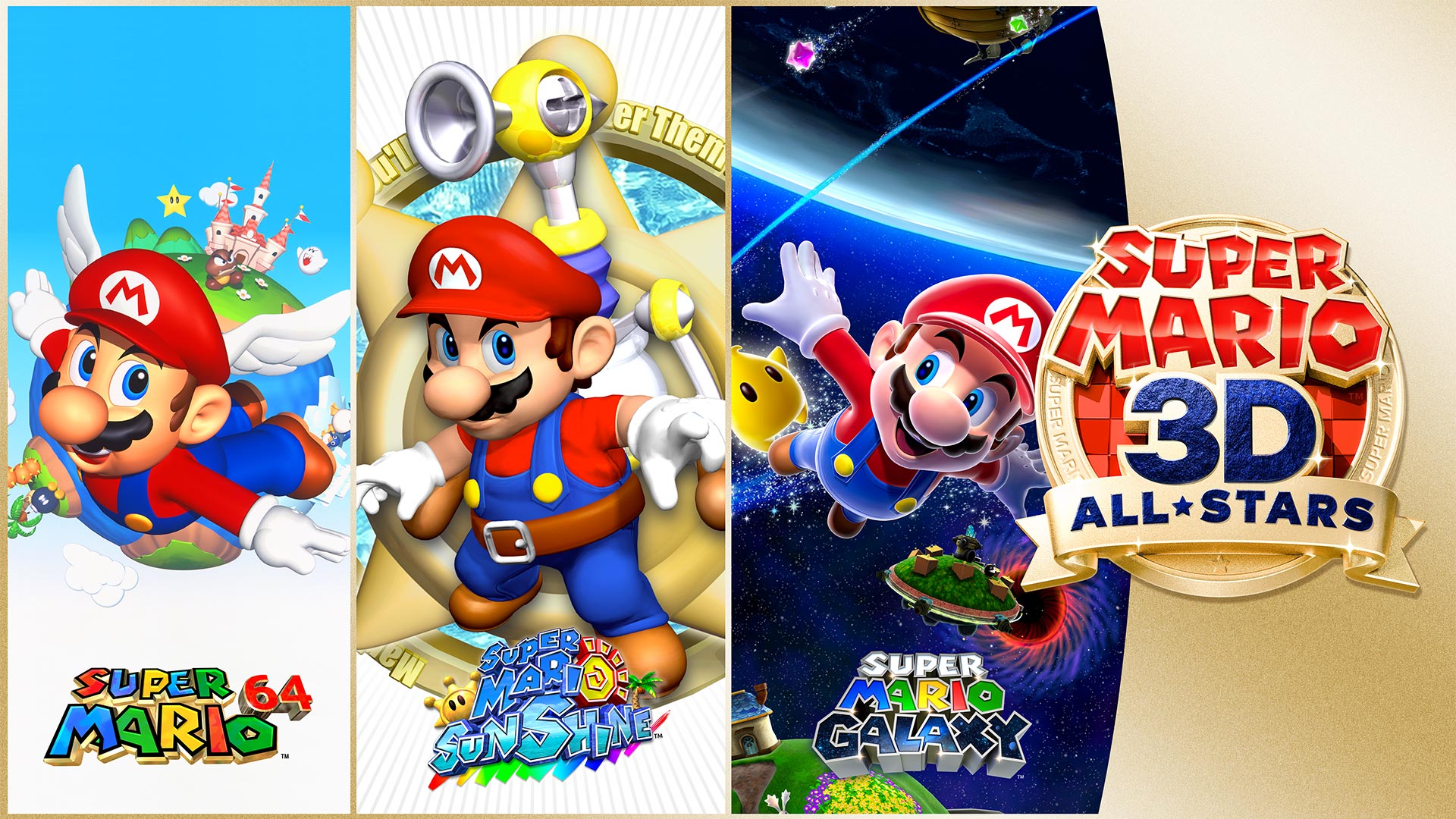
Nintendo rarely ever releases compilations of their beloved classics. Super Mario All-Stars on the Super Nintendo was a unique moment when the venerable publisher bundled the four original NES Super Mario Bros. games together on a single cartridge.
The value was unprecedented and Nintendo updated the visuals to take advantage of the leap from NES to SNES. This compilation was so uncharacteristic of Nintendo that the same rom was put on a Wii disc as a re-release and had no enhancements and no Super Mario World.
As time ravages on, some of Nintendo’s games become lost or extremely rare. Super Mario 3D All-Stars is a much needed compilation that will preserve (for a limited time) some of the best 3D platformers of all time. Just in time for Mario’s 35th anniversary, does Super Mario 3D All-Stars honor gaming’s biggest icon?
Super Mario 3D All-Stars
Developer: Nintendo
Publisher: Nintendo
Platforms: Nintendo Switch
Release Date: September 18, 2020
Players: 1-2
Price: $59.99
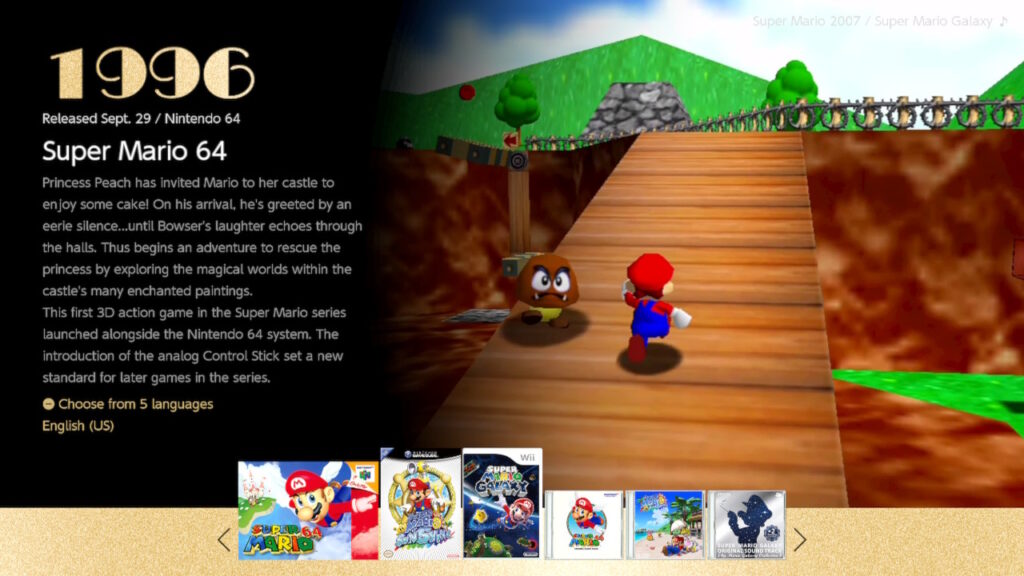
When people think of the concept of ‘video games”, one of the first things that comes to mind is Mario. He is the embodiment of video games and his popularity and appeal is only outdone by Pokemon’s unfathomable earnings. Everyone in the world knows who Mario is and at one point has probably played one of his games or two.
Super Mario 3D All-Stars is a compilation of the plumber’s first three 3D platformers: Super Mario 64, Super Mario Sunshine and Super Mario Galaxy. Sadly, Super Mario Galaxy 2 was not included despite it being one of the stronger 3D Mario games. The compilation is shockingly anemic for what is supposed to be a celebration of Nintendo’s most beloved character.
Super Mario 64 was the most important 3D game ever made. It established what was possible in a fully 3D setting and a control scheme that felt intuitive and easy to play. This was a revolutionary title and yet Nintendo hardly put much effort into it and the only extra is a music player for all three games.

The 3D Mario games have good music, but they are not exactly the kind of tracks you might listen to on their own. The biggest missed opportunity was not allowing players to mix up the in-game music, so they don’t have to listen to the countless times Super Mario 64 recycles the obnoxious Slider. It was a great feature in Super Mario Odyssey and its a shame it isn’t here.
Super Mario 64 was one of the first 3D platformers, but you wouldn’t know it when playing it. The control over Mario is as tight as ever and his range of mobility and momentum is far more advanced than the likes in his most recent game. The only aspect of control that has shown its age is the camera system.
Super Mario 64 was a prototype for all future 3D games to build off of and so it also came with some growing pains. Camera control is done through fixed increments and there is no full 360 degree control. It is not ideal in some instances where it can be troublesome to get a better view for narrow walkways or to just see what is ahead.
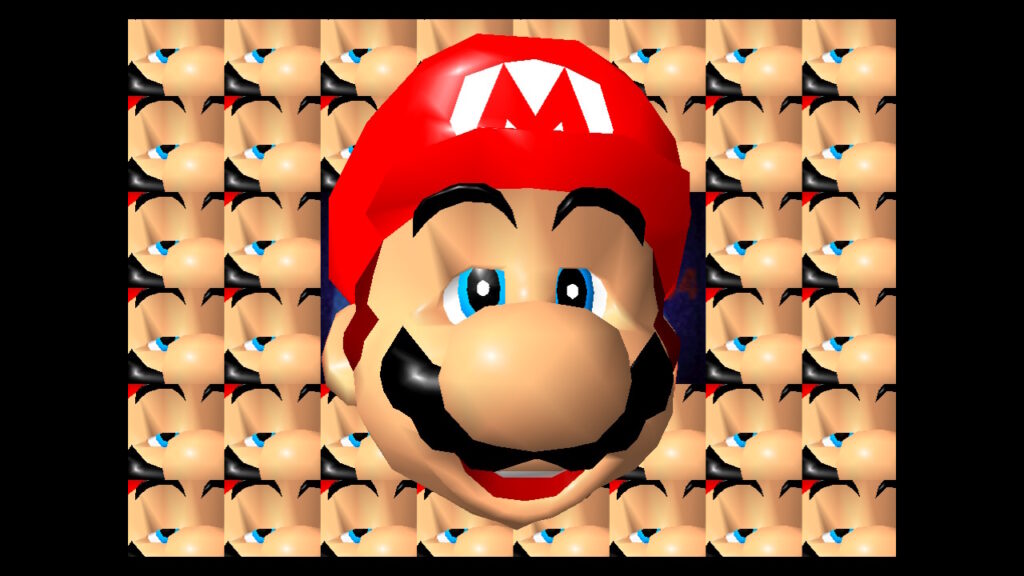
The visuals were obviously not going to hold up over 25 years later. Super Mario 64 was a Nintendo 64 launch game after all and it shows. The extremely low poly count and vaguely muddy textures do have a certain quaint charm despite their antiquity.
The shapes and geometry just barely resemble the objects they are supposed to be. Your imagination has to do a lot of the leg-work to realize some of the things you are looking at. This was doubly so on the original hardware where the game ran in 240p resolution.
In 3D All-Stars, Super Mario 64 displays a very crisp 720p in both portable and docked modes. This also allows some of the old flaws to be more noticeable and in some instances show things that were never possible to see. Mario’s lower poly model is very obvious in distant and wide shots, even in in portable mode’s smaller screen.
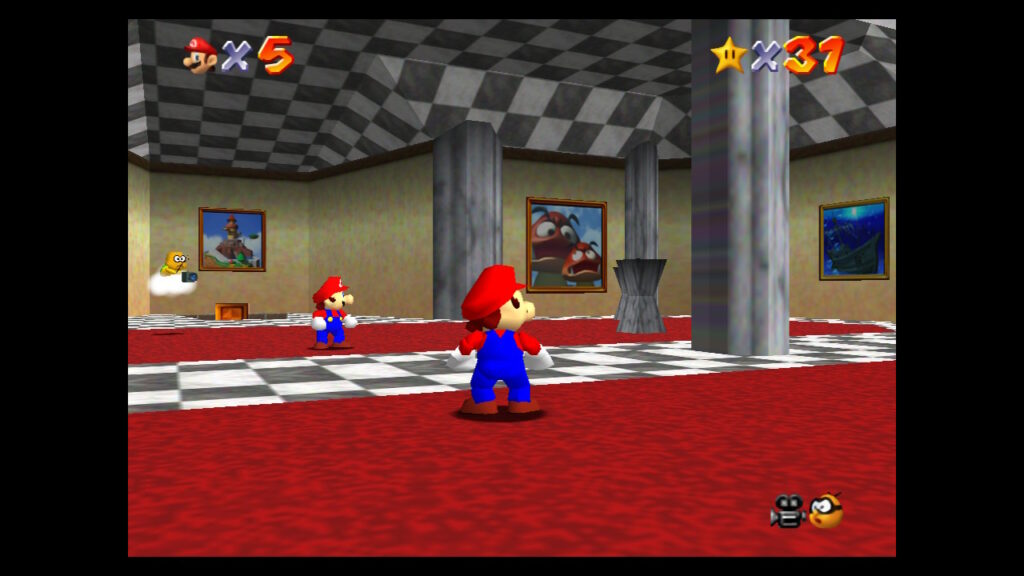
Games on the Nintendo 64 had a very distinct graininess to them. This effect is lost in the sharp, crystalline clarity that makes every edge very harsh. Some textures have been noticeably cleaned up to great effect and even text and hud elements have been improved for the better.
The frame-rate was never too bad in the original, largely maintaining 30 frames per second. In 3D All-Stars, Nintendo has taken a very reserved approach and has maintained the original fluidity, while smoothing out the few trouble spots the original game did have, like in Dire Dire Docks.
It is disappointing that there were no efforts to increase the frame rate to 60 or to expand the aspect ration to 16:9. Sadly, the 4:3 display cannot be changed and Nintendo neglected to include any options for border art. These are basic features that the modding community have figured out. This is one of the most important games ever made, and Nintendo put the barest amount of effort in its presentation.
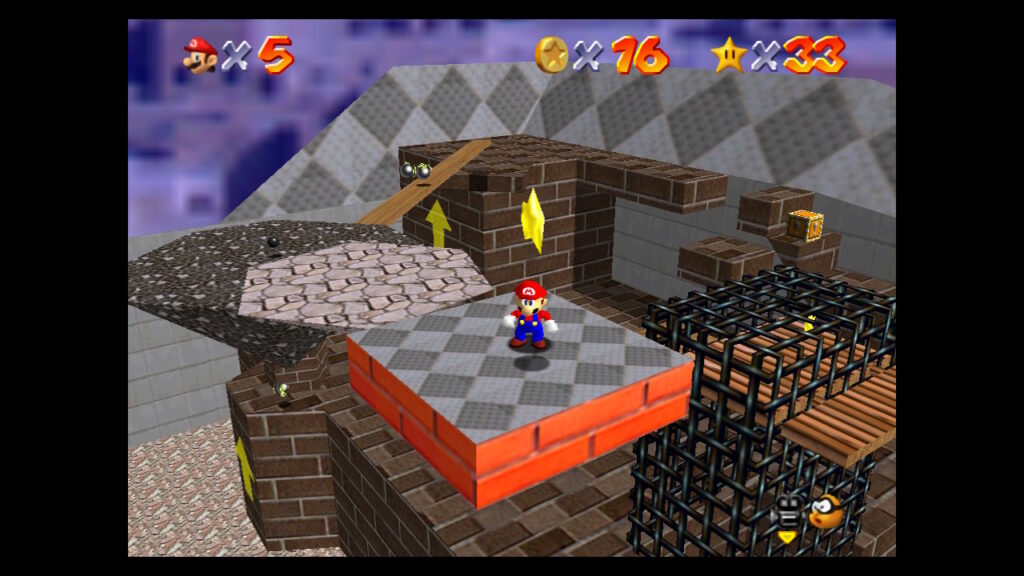
Collecting stars that open up more areas to play more stages allows players to explore and play at their own pace. Some levels focus more on platforming and others might have a focus on sliding. Worlds with a bottomless pit are generally the more challenging areas and are gradually made more prominent as Mario ascends Peach’s castle.
The flaws in Super Mario 64’s design is how many levels wear thin due to a lack of creativity. While the stages are indelible and masterful examples of level design, the same can’t be said about many of the recycled scenarios in a single stage. Too often a level will require Mario to scale the same peak multiple times for a star.
In the first stage, the game tricks the player into climbing the same mountain by redressing up the mission parameters and it just becomes tiring. Womp’s Fortress demand’s Mario to climb to the peak to fight a boss, climb the peak to climb a tower and to collect eight red coins which inevitably requires him to reach the peak again.
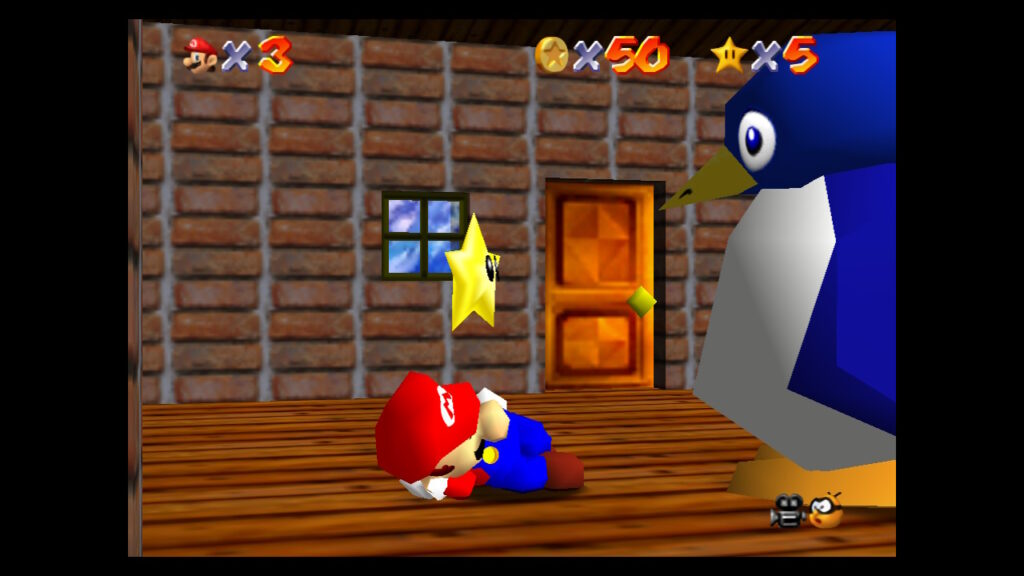
This is especially egregious with the latter levels like Rainbow Ride which requires Mario to sit in a very slow moving carpet ride at the start every single time. Having to always start at the very bottom of Tick Tock Clock is also grating and the fact both of these stages use the Slide theme is just mind-numbing.
This pattern of mission design is through the entire game’s worlds in order to make sure every stage meets a quota to have a certain amount of stars. Thankfully, most of the stars can be acquired regardless what the mission screen tells you. Most of the joy in Super Mario 64 is experimenting with Mario’s mobility and seeing where he can and can’t go.
It is not worth trying to collect all 120 stars since the reward is embarrassingly pointless. The amount is likely this high to facilitate options for the player. Not a fan of Rainbow Ride? It never has to be played to achieve the 70 stars to gain access to the final boss. This was one of the most forward thinking design flourishes in Super Mario 64.

Super Mario 64’s aesthetics may not be to everyone’s liking given how old it is. If the graphics were updated to be more in line with the modern titles, a lot of the personality would be lost as evident in the Nintendo DS remake.
The setting and vibe is almost dream-like. The worlds are a series of nonsensical platforms, often made of stone or some other abstract material. The skybox depicts strange vistas or endless voids. Mario will be exploring a strangely empty castle, only to be transported to a series of towers in the sky and he will be flying.
It is almost as if the entire game is Mario having a dream. The complete disconnected way the worlds are bound together will make it hard for some people to take anything seriously, but this is part of what made Super Mario 64 so magical. It was many gamer’s first time stepping into a 3D world and it is still one of the most surreal.
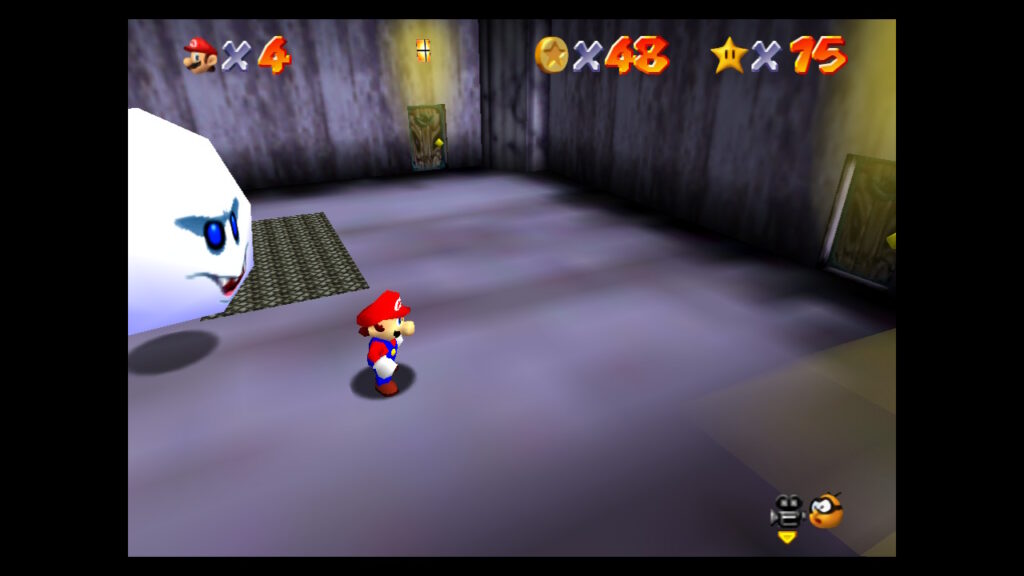
After the Nintendo 64 had come and gone, Nintendo released their first disc-based console; the Gamecube. This was and still is one of the most unusually designed consoles; resembling a purple lunchbox. This “left-field” approach to design would be the basis for many of the games Nintendo would release and would apply to the sequel to Super Mario 64.
How does Super Mario Sunshine mix things up from its predecessor? In pretty much every way imaginable. More 18 years after its release, there is still no other Mario game that starts the way Sunshine does. Beyond its unusual premise and setting, the gameplay in Sunshine integrates a major change with F.L.U.D.D..
With every entry after Super Mario 64, Mario’s move-set changes and usually makes some cuts. The F.L.U.D.D. in Sunshine is the rare instance where the reduction of abilities is made up for with new ones. Mario’s range of mobility and momentum is expanded upon in ways no other 3D Mario game has touched since.
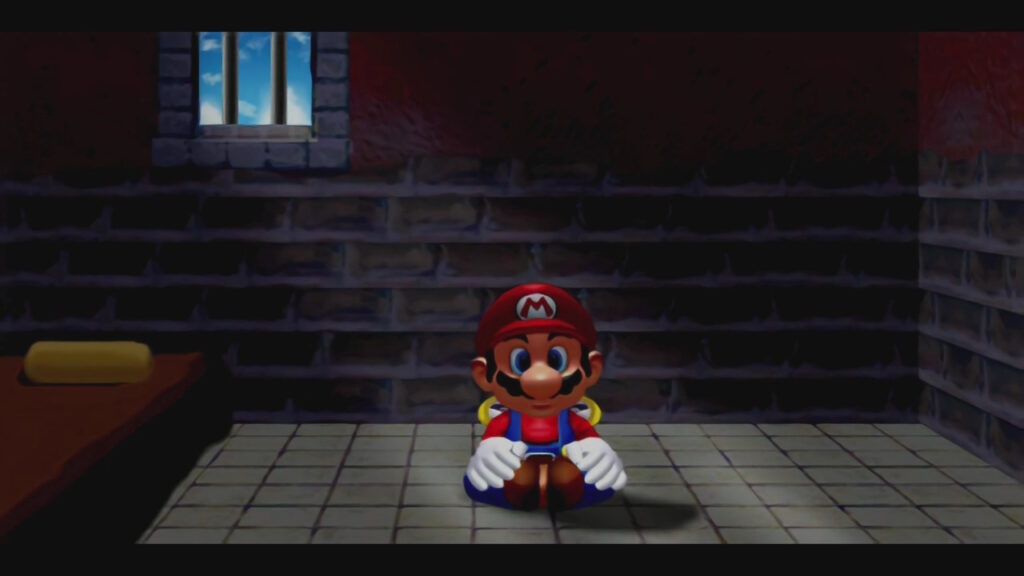
When Sunshine begins, it opens with a cutscene that has Mario characters actually speaking dialogue with voice acting. In a humorous turn of events, Mario ends up in court and gets sent to prison. After serving some time, he is forced to do community service which involves cleaning up the resort town of Isle Delfino.
This is where F.L.U.D.D. comes in and expands Mario’s abilities where there were cuts made. Punching and jump-kicks are gone and Mario can no longer do the traditional long-jump. Instead, F.L.U.D.D. can spray in a variety of ways depending on Mario’s action.
Depending on which nozzle the F.L.U.D.D. has equipped, Mario may have a totally different set of abilities. The hover nozzle is something you’ll almost always want as Mario’s default since it is useful for extending air-time. The skill-ceiling can become very high for a 3D platformer when mastering the different nozzles the F.L.U.D.D. can equip.
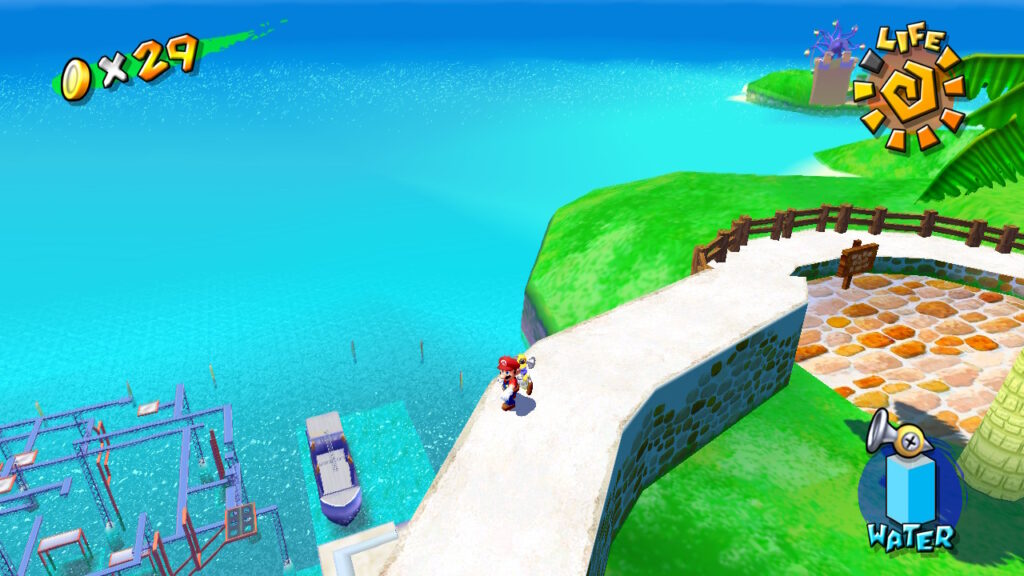
One aspect that makes Sunshine so unique from other Mario games is its dedication to crafting an actual world. Most of the time, the settings in Mario games are disconnected and abstract platforming gauntlets/sandboxes without any logic behind them.
Sunshine commits to the island resort setting and makes the entire location feel believable and gives it a sense of place. It is even possible to look out into the distance and see other areas that will become accessible. This makes Isle Delfino feel more immersive and tangible.
Every area feels cohesive and has a reason for existing. The locations are not just a series of platforms for Mario to jump on; there was thought put into every structure to add some plausibility. This goes a long way in selling the “vacation destination”, atmosphere which is strong.
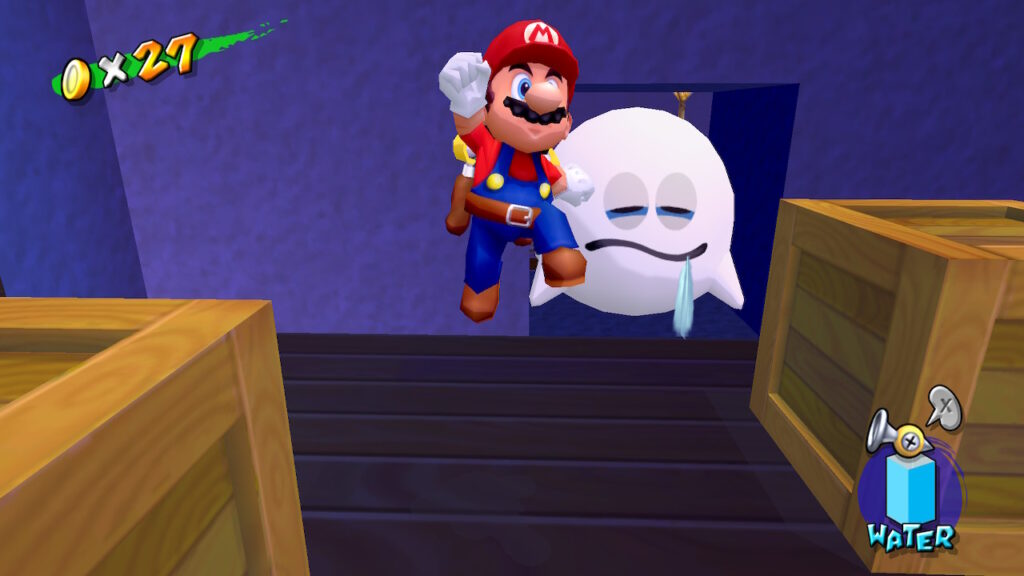
The only downside to this is that the beach theme is consistent through the entire game and could become uninteresting to some players. Stages will always feature water and rarely have any bottomless pits. This to encourage free-form exploration and capitalize on F.L.U.D.D.’s ability to launch Mario large distances.
Sometimes a mission will require Mario go into a pocket dimension where the game will have abstract levels like Super Mario 64. These challenge stages will take away F.L.U.D.D. and will put your platforming skills to the test since Mario’s move set becomes very limited without it. These are healthy reminders just how useful F.L.U.D.D. actually is.
These challenge stages also highlight just how tight and responsive Sunshine‘s controls are. The loose and crudeness of Super Mario 64’s handling is gone with Mario able to snap into a side jump extremely fast and fluidly. The dive maneuver can be done almost infinitely, making it a reliable replacement for the missing long jump.
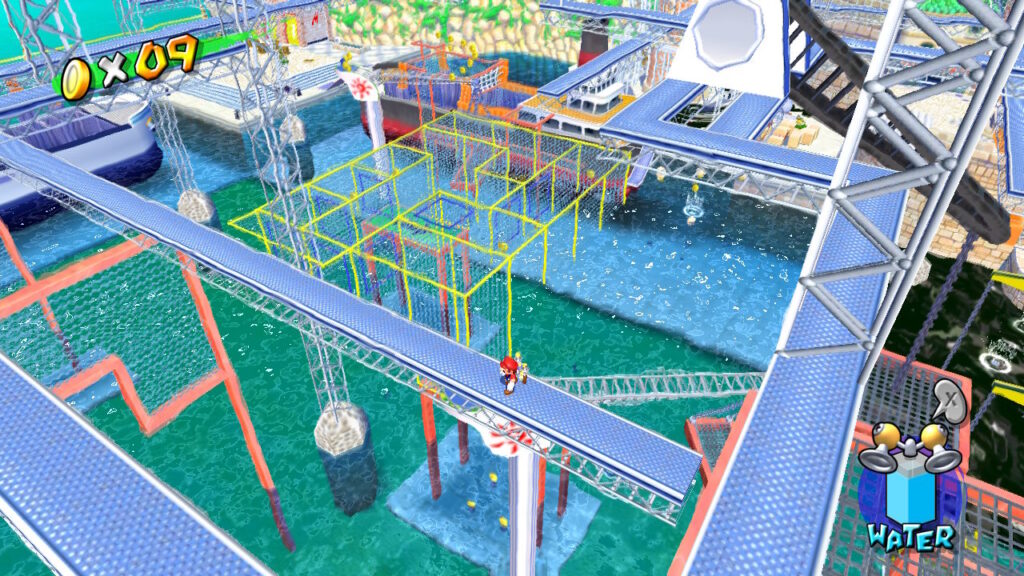
While Sunshine and 64 both have 120 stars, Sunshine has fewer levels. This is made up for with Sunshine‘s stars being more involving to acquire and having more creative scenarios to earn them. Mario won’t be forced to climb the same structure to a sickening degree and the nonlinear level design makes it so that there is less redoing of the same obstacles.
One tedious flaw that Sunshine and 64 both suffer from is getting booted out from a level after earning a star. It is made worse in Sunshine because you have less freedom to earn stars in any order. The range of options Mario had in levels in 64 allowed players to earn most stars in any order they wanted from simply exploring or experimenting.
Sunshine is much more rigid with its approach to collectibles. The only saving grace is the blue coins which are functionally like a star, but do not kick Mario back to the Delfino Plaza. There are over 200 blue coins and for every 10, nets Mario a star from the degenerate raccoon in the town square. These are much trickier to find and demand more skill to earn, typically requiring fast reflexes.
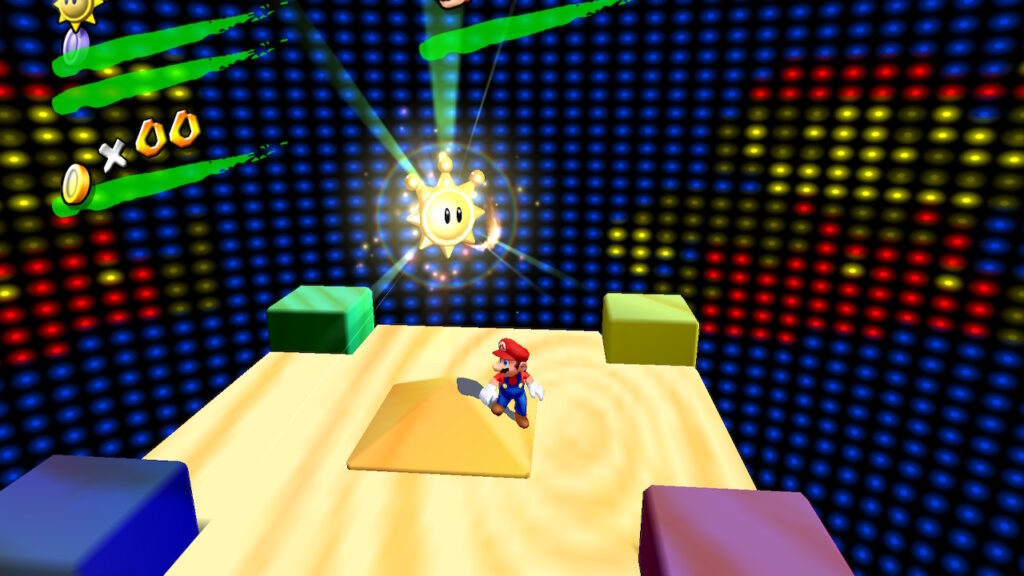
Out of all three games in this compilation, Sunshine‘s visuals have aged best. While it is disappointing that it is still 30 frames per second, Sunshine has higher detailed character models and shows off more effects than Super Mario Galaxy. The trade off may have been the frame rate, but now there is no excuse since the modding community has figured out how to do it.
Nintendo took the effort to expand the aspect ratio to 16:9 and even sharpened UI and smoothed out the FMV cutscenes. The image quality displays a very crisp 1080p while docked and the wide range of colors and glistening effects make Sunshine the slickest looking game of the bunch.
Super Mario Sunshine may not be perfect, but it is interesting. It is the Majora’s Mask of the Super Mario franchise in many ways due to its bold and experimental approach to series conventions. 3D All-Stars will finally give it a second chance and for others to discover its finer qualities.

Between all three games, Sunshine is most improved. The aspect ratio expanded, resolution bump and the effort put into the clean-up of the cutscenes suggest that this was the game that got the most attention. Super Mario Galaxy is the title that got the least attention, but only because there isn’t much room for improvement.
Galaxy‘s changes are mostly in its 1080p resolution boost and the translation of the Wii specific features to Switch controls. When it was on Wii, Galaxy was already in the wide-screen aspect ratio and maintained 60 frames per second.
There really was not much room to improve upon with Galaxy when porting it to the Switch. The tricky part is its unique control scheme which was designed around the Wii-remote and nunchuck. The success of this transition depends on how you play; portable or docked.
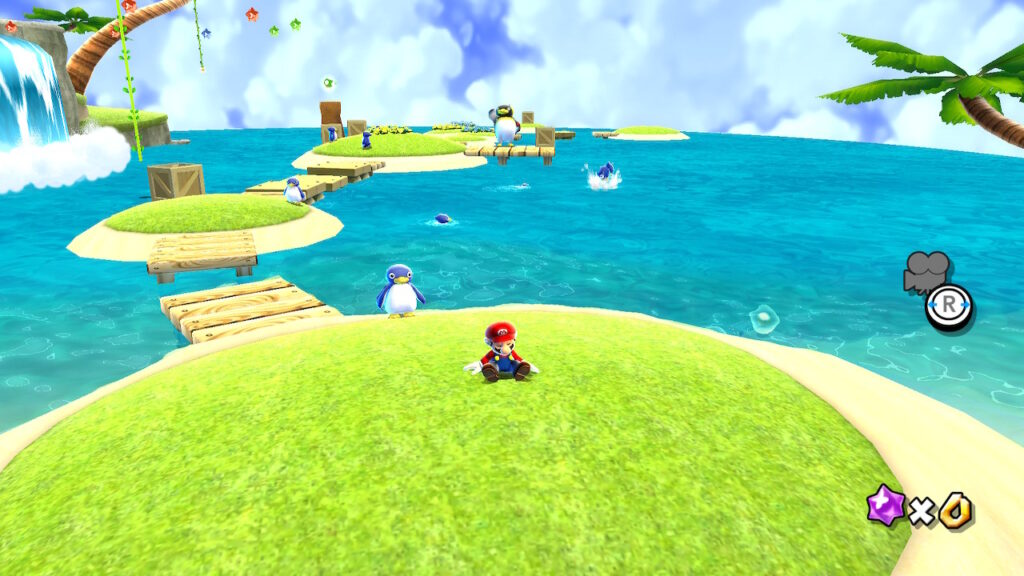
Mario’s controls and move-set has been drastically simplified since 64 and Sunshine. Only having his triple jump, long jump, side jump and back flip; you’ll find his handling has also been made slower and floaty in the air.
Mario does not punch or dive anymore. Instead he does a a Tasmanian Devil style spin-attack which is no longer restricted to waggling the control. Being able to press Y to instantly smack goombas is so much more responsive than motion control ever was.
The pointing mechanics of the Wii-remote have been awkwardly redone with the Switch gyroscopic controls. It is no where near as accurate as the pointing was and requires constant recalibration as evident of the need to have the right shoulder button dedicated to centering the cursor.
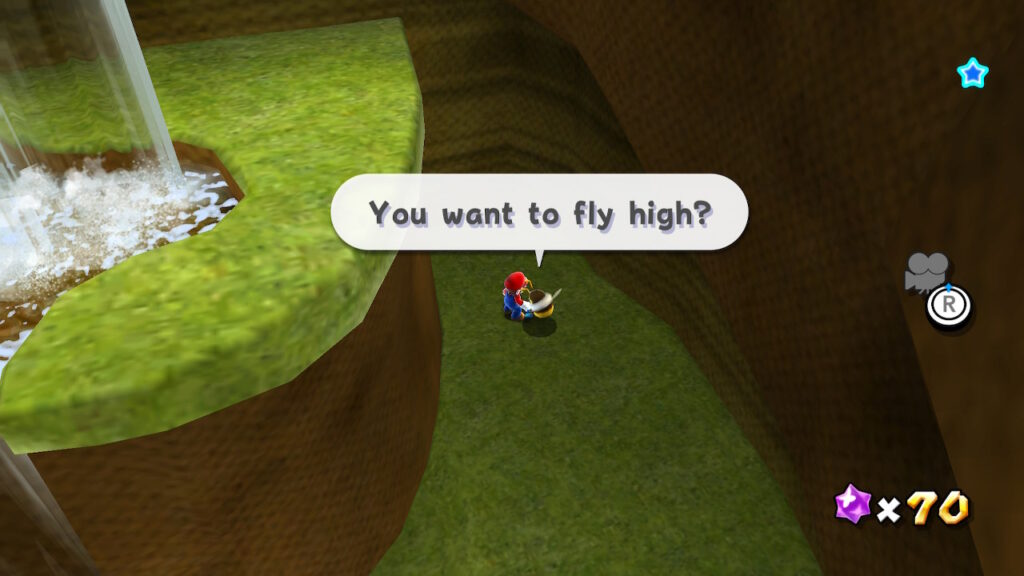
Playing handheld completely circumvents the need for unreliable gyroscopic aiming because shooting star bits and collecting them is done with the Switch’s touch-screen. This also applies to the gravity stars to tug Mario in zero gravity. It works well, but it also means having to move your hand away from the main controls and leaves Mario vulnerable.
Other moments in Galaxy that require the use of aiming or the gyroscope for controlling Mario are not suited for portable play at all. Whether he is riding a large stingray or a large ball; twisting your arms and body around while holding the Switch to control Mario is a liability.
Controlling Mario in Galaxy may not have the same depth as seen in its predecessors, it makes up for it in sheer variety. There are so many scenarios and unique set-pieces per world that makes the same level feel very different. Some worlds will be dedicated to a single star and never be reused again, keeping the flow of content always feeling fresh.
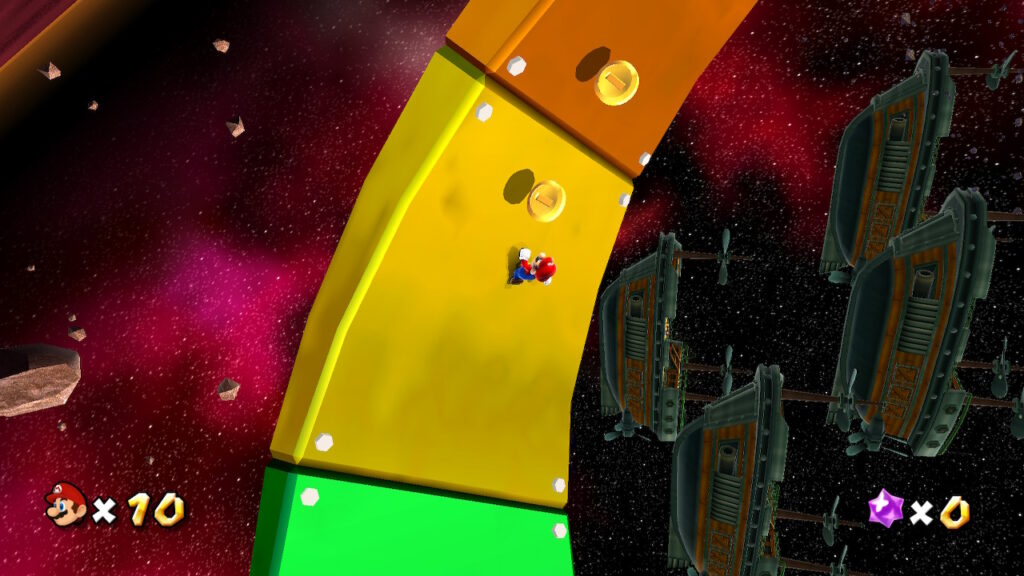
Mario is rarely doing one thing for too long and the levels are always throwing gimmicks at you to overcome. The only downside to all this is that Galaxy feels very scripted and linear as a result. Like Sunshine, there is almost no way to deviate from the mission and earn a different star.
The few times Galaxy does recycle content, it is for the challenge stars that put a new spin on previous missions. Modifiers like having to complete a stage with limited time or dying in one hit is an economical but effective way to make the most out of the core game. These are the closest that Galaxy gets to a “hard mode”.
The Gamecube and Wii had specs that were not drastically different. Nintendo’s artists certainly have their work cut out for them and know how to get the most out of limited horse-power. Sunshine may be the most vibrant in this compilation, it is Galaxy that wins out on being the most fluid of the collection.
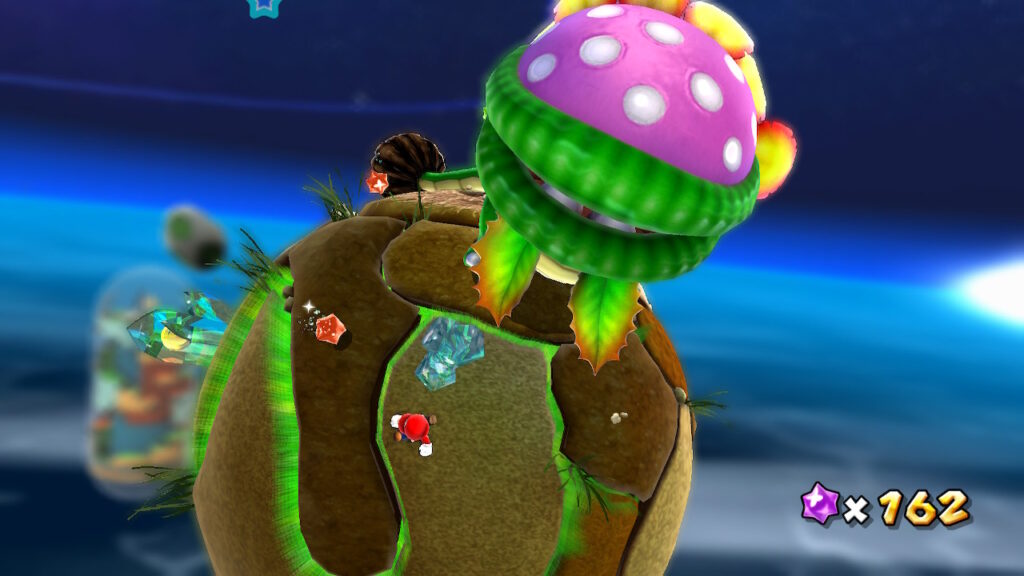
The higher frame rate came at a cost. Galaxy is noticeably less detailed than it predecessor. The polycount is lower than in Sunshine where minor Toad NPCs would have individual fingers. In Galaxy, NPCs barely have hands at all. In 1080p, Galaxy’s lower polygon models are much more apparent and are more distracting.
The aesthetics in Galaxy feel bland and lack style. Most textures are flat looking, everything feels too clean and the locations are either sparse or very small. The most impressive visual flourish is the out of focus photographic effects for distant objects.
The level design has also gone back to the nonsensical and abstract worlds as seen in Super Mario 64, but with the context of everything in outer space. This is supposed to ground the setting like in Sunshine, but the ideas and concepts rarely feel coherent to ever be believable like how Isle Delfino was.
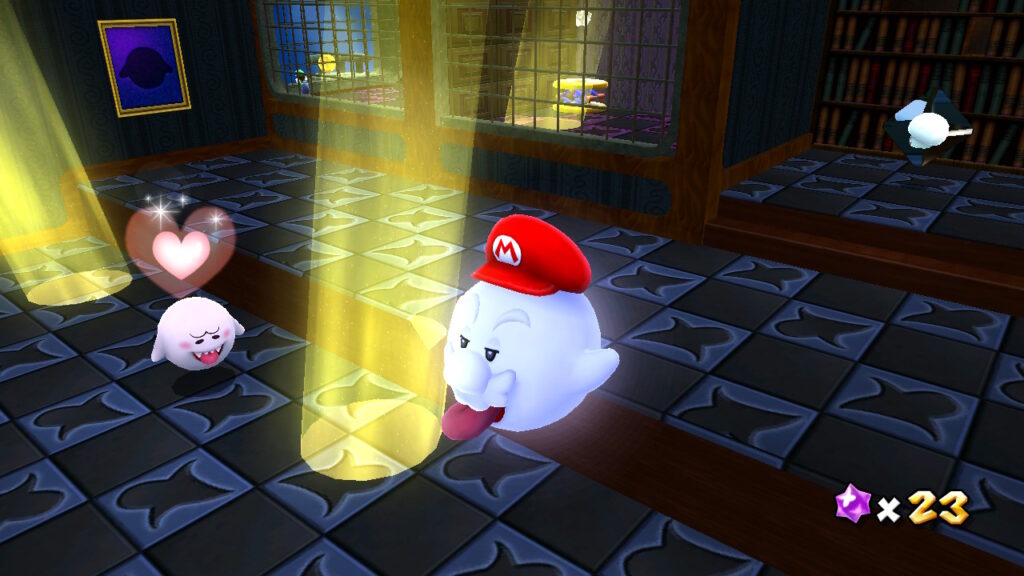
All three titles in Super Mario 3D All-Stars are all highly enjoyable games. They all aren’t perfect due some aspects being so old or outdated, like in the case of Super Mario 64‘s camera system. In other cases, some flaws are the result of chasing the casual audience or being so experimental and different.
3D All-Stars is chock full of content that it will satisfy most people. Disappointingly, it is missing the better Galaxy game and none of the mini-games from the DS port of Super Mario 64 made it in. All three games are almost 1:1 straight ports, with barely any features or quality of life improvements added.
This was the chance for these three titles to get definitive versions, but instead these are mostly alternatives to the originals. In spite of Nintendo’s low-efforts, the quality of the games themselves are high enough that make them worth your time. Super Mario Sunshine especially is noteworthy since used copies are usually cost-prohibitive and Gamecube controllers are getting harder to find.
Super Mario 3D All-Stars was reviewed on Nintendo Switch using a retail copy purchased by Niche Gamer. You can find additional information about Niche Gamer’s review/ethics policy here.